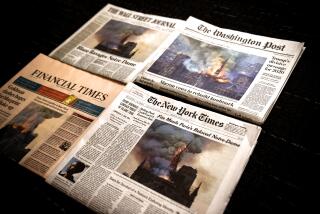Media : Punch Losing Clout on British Newsstands : * The humor magazine was once on the cutting edge of popular English culture. But now its circulation has plummeted and its very existence is in question.
- Share via
LONDON — Ever since its first issue 150 years ago Wednesday, the English humor magazine Punch has poked gentle fun at British life and customs in essays, jokes, criticism and cartoons.
For much of that time, Punch has been a weekly national institution: No newsstand, dentist’s waiting room or social club library was without a copy of the magazine, which is named for the character in the puppet show Punch and Judy.
But an unfunny thing happened to Punch on the way to the late 20th Century: It has fallen out of favor. Circulation has plummeted, and its existence is in jeopardy.
“Punch has had a noble history,” editor David Thomas observed. “But our most important task is looking forward, not back. I’m trying to establish a new format that will see Punch through the next 10 years.”
Thomas, 32, the son of a diplomat and a graduate of Eton and Cambridge who was a successful magazine writer, has his work cut out for him.
Punch, which was once required reading for opinion makers in Britain, dropped in circulation from an immediate post-World War II high of 195,000 to 100,000 by 1975 and 65,000 by 1980. Then it went into a free fall to below 30,000 in late 1989, when Thomas became editor and arrested the decline.
Circulation is now about 33,000 weekly. “These are tiny rises, but we are bucking the trend,” Thomas candidly pointed out over lunch at Soho’s Groucho Club. “We are losing money, but if we get the circulation up to 50,000, which I think possible in 18 months, we will make money. And if we should hit 100,000, we would make really serious money.”
That’s why publisher United Newspapers, which also prints the Sunday and Daily Express, has not abandoned the money-losing Punch. As Thomas put it, “Punch has the potential for a much higher circulation ceiling.”
Many critics believe that Thomas may be whistling as Punch nears the graveyard.
Former Editor Alan Coren argued that “re-launches” of failing publications are rarely successful in Britain. “I don’t think you can consciously go out to find new readers, the 18-to-30-year-olds,” he said.
Coren and other observers believe that Punch’s mild humor and spoofs became passe with the arrival on the scene first of television, then of more hard-hitting competition like the biweekly Private Eye, which offers an earthy blend of financial fact and political and social gossip. Its circulation has hit 200,000.
Further, these observers say, in recent years, London national newspapers have expanded their coverage of subjects originally left to magazines and hired away the more talented writers. The papers sell for less than half of Punch’s cover price, which is equivalent to about $2.
As former Punch art editor Sheridan Morley pointed out: “Every national newspaper now has what amounts to a free magazine on Saturday or Sunday, and Punch is competing with them for readers, as well as for advertising.”
Then, too, a new and raw down-market humor magazine called Viz, featuring comic strips and scatological jokes, has come out of nowhere and rocketed to sales of more than a million copies bimonthly. Coren commented: “We have a real trash culture in England.”
Punch, which was originally subtitled the London Charivari, or hubbub, first came out when Queen Victoria was only four years into her reign. It promised its “gentle public” that its pages would “have no other object than the moment’s approbation--an end which will never be sought for at the expense of others, beyond the evanescent smile of a harmless satire.”
At first, it took an irreverent approach with Mr. Punch--a champion of the poor who lampooned people, events, social conditions and the vagaries of progress by word and by drawing. But after its first 30 years, it became more a reflection of its middle-class readership.
In 1895, Punch teased the euphemistic style of the clergy with a cartoon titled “True Humility.”
“I’m afraid you’ve got a bad egg, Mr. Jones!” the Rt. Rev. Host says to a guest spooning a soft-boiled egg.
“Oh no, my Lord, I assure you!” the curate responds tactfully. “Parts of it are excellent.”
In the “golden age,” Morley calls the period from the 1930s to the 1960s, writers and editors in Punch’s old Fleet Street office traded ideas around a wooden table, on which guests were encouraged to carve their initials. “It was like the Algonquin table for the New Yorker writers and artists,” he said.
But after World War II, Punch seemed to lack the energy, say, of National Lampoon or Mad magazine, and it did not branch out into longer (and humorless) fiction and nonfiction pieces as did the New Yorker.
Today, said another humor columnist, Miles Kington, “Punch is mainly a place for cartoons and the writing of light essay stories. Punch has been going downhill for about 40 to 50 years. It can only survive if it has a function, and the last time it had a function was during the Second World War. Reading Punch is a habit you can drop easily.”
Punch’s most famous editor was the irascible Malcolm Muggeridge, who departed the job 34 years ago, declaring, “There is no occupation more miserable than that of trying to make the English laugh.”
Coren points out that these days most magazines are targeted to a specific audience, and Punch never found its postwar niche. “I think the Yuppies the new editor would like to get are too busy to read a magazine like Punch,” former editor Coren said. “They want something with a ‘need to read,’ and that’s why The Economist is so successful.”
Still, new editor Thomas--who describes his views as the “voice of trenchant skepticism in the face of received opinion”--believes that he has a fighting chance to put editorial punch back into Punch.
In October, 1990, the magazine presciently ran a cover story on “The Men Who Would Be Maggie,” with sarcastic sketches of those most likely to replace Margaret Thatcher as prime minister. (Thatcher made the surprise announcement that she would step down a month later.) Punch’s cover illustration depicted John Major--who a few weeks later succeeded Thatcher at No. 10 Downing Street--wearing an Iron Lady look-alike wig.
A cartoon in that issue showed a lecherous male bear inviting a female bear into a cave, with her saying: “Not without a pre-hibernation agreement.”
Thomas points out an example of the different way he said the magazine approaches stories. “The Sunday (London) Times ran a story about garbage of various notables. Once, we might have had Alan Coren write a whimsical essay about it. Instead, we sent a reporter to examine the garbage of Sunday Times Editor Andrew Neil--and found, among other things, the bronzer he uses to keep a tan.”
Punch’s publishers have mounted a million-dollar television advertising campaign for the magazine, and Thomas points to his success in bringing aboard American humor writers like P.J. O’Rourke.
But compared to the New Yorker, he admits that his rates are “peanuts” for contributors: about $100 for a small cartoon; about $340 for a full page and $600 for a spread. Writers get about $500 for a full-page essay.
With a small staff of seven full-time editorial employees whose age averages about 27, Thomas puts out a 56-page issue every week from the seventh floor of the United Newspapers building. The magazine reaches London readers on Tuesdays and others a day later.
“I think our humor nowadays is less whimsical and more geared to the facts,” he said. “But we have to be more imaginative and quicker than the newspapers on subjects we choose to address.
“People who haven’t read Punch are always surprised by what they find in it--it doesn’t fit their preconceptions. And I am eager and dumb enough to think we can do something with a new Punch.”
In that, he will be encouraged by all the former editors and writers for Punch, however glum they may be about the magazine’s chances.
As Sheridan Morley said: “If magazines survive into the next century, Punch deserves to be with them.”
More to Read
Sign up for Essential California
The most important California stories and recommendations in your inbox every morning.
You may occasionally receive promotional content from the Los Angeles Times.












